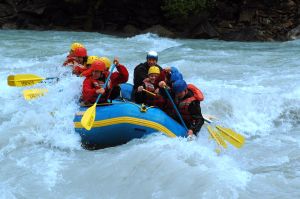AllCampgrounds Outdoor Adventures: Your First Rafting Trip
Last time on AllCampgrounds, we got started looking at the thrilling and often challenging world of river rafting. Now that we know the basics of finding a river and a raft – and that you don’t have to bring Jean-Claude Van Damme along to safely work your way through a beginner river – it’s time to look at some basic techniques for navigating that current.
Tips and Tricks for Your First Rafting Trip
Get informed before you go: Not all campsites are right for rafting, but there are thousands of camp grounds around the U.S. and Canada that offer guided trips downriver. For your very first trip out without a guide, you definitely want to select a camp that focuses on its rafting as a main feature, even if only to find out from experienced rafters what kind of challenges you might face around the bend. In many places, you can get handy river guidebooks to study, too.
Make sure everyone is comfortable: When it comes to rafting, there’s safety in numbers, even in well-developed camp grounds. To get the most out of your trip, you’ll need at least a small crew of friends. Make sure everyone is “on the same page” and understands the river, the currents you’ll be up against, and procedures in case of emergency. We’ve all seen the cartoon where one guy on the boat is facing the wrong way – don’t let this be YOUR team on your first time out!
Always start on Class II rivers: It’s a good idea to get some professional instruction in water rescue and emergency response before moving on to Class III river rafting. Besides that, a few good trips on Class II rivers will teach you the vital skills to keep an eye out on what’s ahead and anticipate any trouble, without losing the concentration you need to keep your raft on track. There’s no stop, slow, or reverse on a raft, and even for the best, the decision-making skills take a while to cultivate.
Take things head on: It may seem counterintuitive at first, but the main thing to remember in rafting is that you can’t fight the current. If, in spite of everything, you’re going to hit an obstacle, it’s almost always better to hit it square-on. This reduces the odds that your raft is going to tear, turn, or flip over. And speaking of which, be prepared to (safely!) “abandon ship” if need be, floating downstream with the current to a safe exit point. The best way to do this is on your back, with your legs out in front of you.


